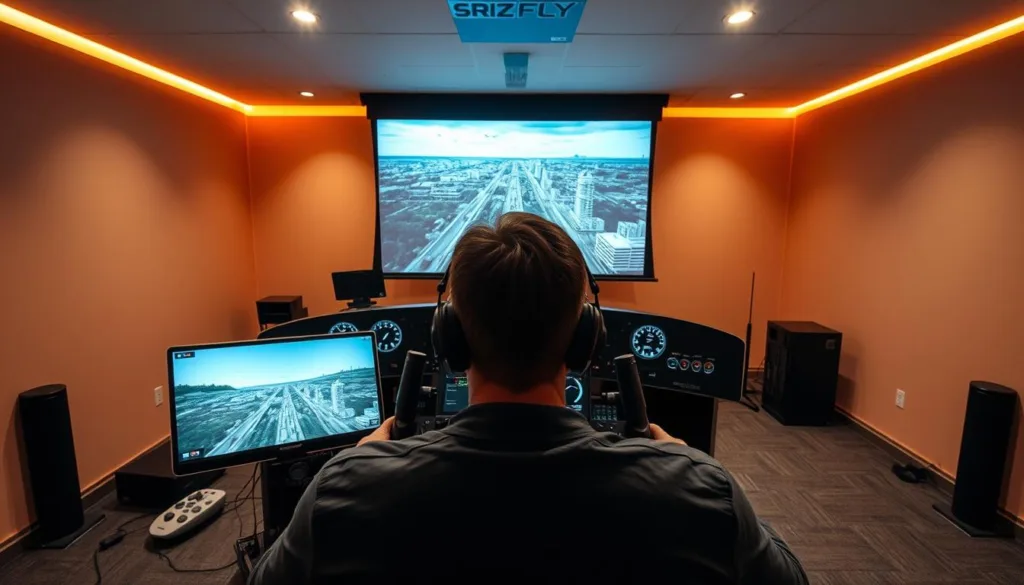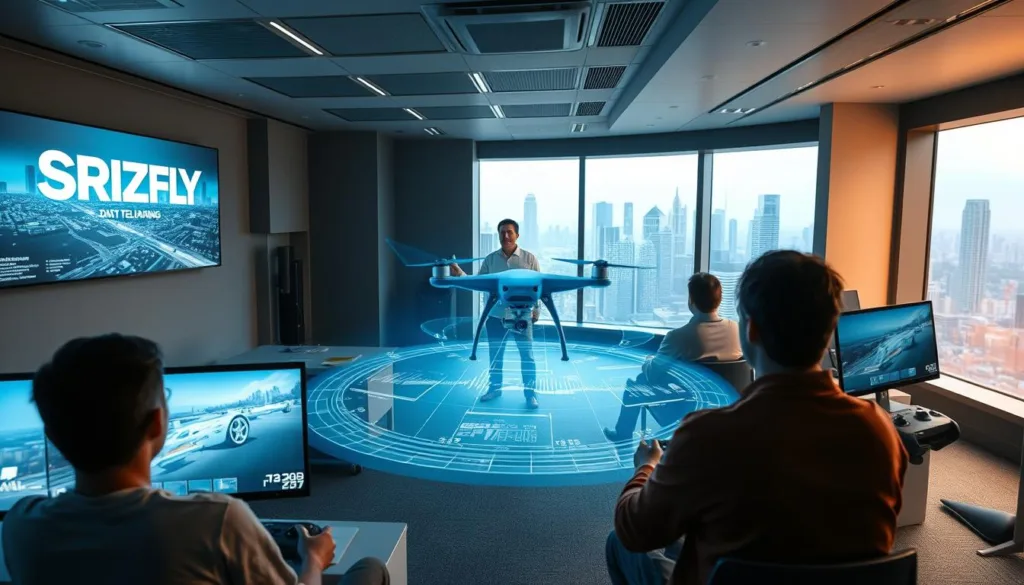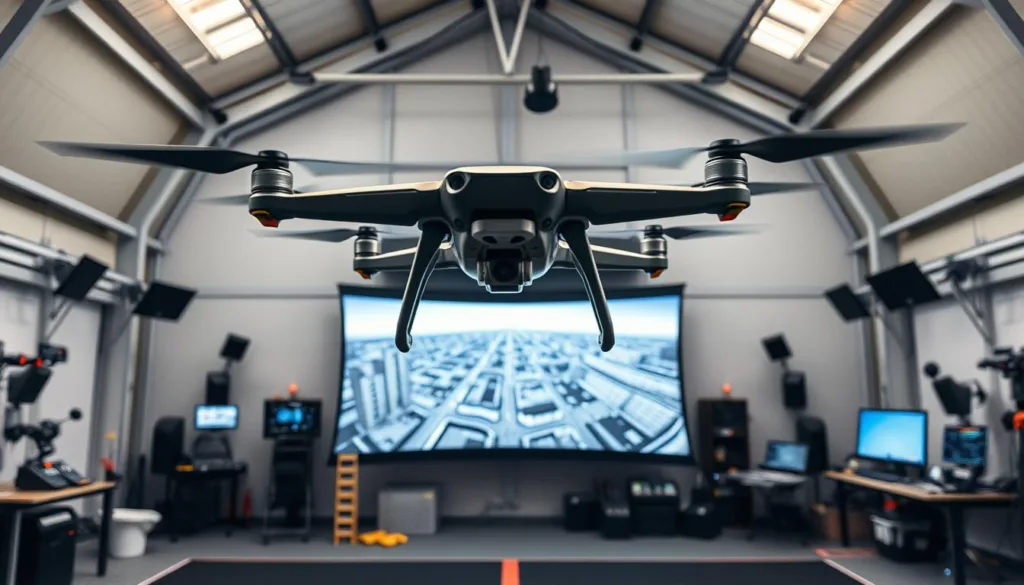Learning to operate aerial devices requires precision, but real-world practice comes with risks. Modern virtual platforms let users build expertise in controlled environments, reducing accidents while cutting costs. These tools replicate real physics and weather patterns, creating lifelike scenarios for skill development.
SRIZFLY’s technology stands out by offering customizable modules that adapt to various skill levels. Instructors can track progress through detailed analytics, identifying areas needing improvement. This approach eliminates concerns about equipment damage during trial-and-error phases.
Virtual practice environments help learners master complex maneuvers through instant feedback loops. Users repeat challenging tasks until achieving muscle memory, accelerating the learning curve. Schools and businesses benefit from reduced insurance premiums and lower operational expenses.
Effective programs combine theoretical knowledge with interactive challenges. The best systems feature updated regulations and emergency protocols, preparing operators for real-world certification exams. This method builds confidence before transitioning to physical devices.
Key Takeaways
- Virtual platforms minimize financial risks during skill development
- Customizable scenarios adapt to different experience levels
- Real-time analytics improve teaching effectiveness
- Regulatory compliance training integrates seamlessly
- Cost savings extend beyond equipment protection
Introduction to Drone Simulation Training
Mastering aerial operations no longer requires risking expensive equipment or personal safety. Advanced digital tools now replicate real-world physics and environmental factors, letting users practice maneuvers in lifelike virtual spaces. This shift has transformed how institutions approach skill development for operators.
Overview of Advanced Simulation Technology
Modern systems use physics engines that mimic wind resistance, battery drain, and device weight distribution. Environmental modeling introduces challenges like sudden storms or low-light conditions, testing adaptability. Learners can crash repeatedly without consequences, building muscle memory faster than traditional methods.
FPV (First-Person View) modules create immersive perspectives through headset compatibility. This feature helps pilots navigate tight spaces or racing courses with precision. Instant performance analytics highlight areas needing improvement, from throttle control to stabilization techniques.
How SRIZFLY Enhances Drone Education
SRIZFLY’s platform stands out with scenario libraries covering photography missions, search operations, and package delivery simulations. Instructors customize exercises to match certification requirements or specific industry needs. Beginners start with basic hover challenges before tackling complex flight paths.
The system’s adaptive difficulty adjusts to individual progress, maintaining engagement without overwhelming users. Multiplayer modes let students collaborate on team-based tasks, mirroring real-world workflows. Schools appreciate reduced insurance costs and the ability to train multiple operators simultaneously on one system.
Why Drone Simulators are Essential for Modern Training
Virtual flight platforms revolutionize skill development by removing physical constraints. New operators gain confidence through risk-free repetition, tackling challenges that would intimidate even seasoned pilots in real-world settings. Crashing becomes a learning tool rather than a financial setback.

These systems slash costs associated with repairs and equipment replacements. Schools save thousands annually while providing 24/7 access to practice sessions. Learners master throttle control, obstacle navigation, and emergency protocols through customizable scenarios.
FPV modules transform how pilots prepare for racing or cinematography. Users experience immersive perspectives that mimic goggles-based navigation. Instant feedback loops highlight errors in altitude management or cornering techniques.
- Weather-independent practice environments
- Unlimited crash repetitions for muscle memory
- Adaptive difficulty matching skill progression
Instructors monitor throttle inputs and flight patterns through detailed dashboards. This data-driven approach pinpoints weaknesses in stabilization or battery management. Teams collaborate in multiplayer modes to simulate search missions or delivery operations.
Repeated exposure to wind gusts and equipment failures builds reflexes critical for real-world operations. Learners transition to physical devices with ingrained spatial awareness and crisis response capabilities.
Understanding the Importance of Safety and Affordability
Virtual practice environments transform how institutions approach skill development. These systems let learners master complex techniques while addressing two critical concerns: operational safety and budget limitations.
Protecting People and Property
Accidents during skill development can lead to costly repairs or injuries. FPV simulation tools remove these dangers by creating digital replicas of real-world scenarios. Students navigate obstacles and weather challenges without risking physical equipment.
Educators report 89% fewer incident reports when using virtual platforms. This allows more aggressive practice sessions where learners push their limits. Repeated exposure to emergency situations builds confidence faster than traditional methods.
Budget-Friendly Learning Solutions
Schools and clubs face tight budgets for equipment maintenance and replacements. Simulation software cuts these expenses dramatically. Below table shows typical savings:
| Expense Category | Traditional Training | Simulator Training |
|---|---|---|
| Equipment Damage | $1,200/year | $0 |
| Battery Replacements | $480/year | $60/year |
| Insurance Premiums | $2,500/year | $900/year |
SRIZFLY’s systems help organizations redirect funds toward advanced course development. Multi-user licenses enable entire classes to practice simultaneously. This scalability makes specialized flight education accessible to smaller institutions.
Virtual platforms also reduce environmental impact. Fewer broken parts mean less plastic waste. Schools can maintain modern programs without constant hardware upgrades.
Exploring the “best drone simulators for training”
Navigating aerial operations safely starts with choosing the right digital tools. Five platforms stand out for their specialized approaches to skill development:
DRL Simulator delivers exceptional value with 30+ structured lessons. Its track editor and multiplayer modes let users practice racing techniques across diverse models. Priced under $20, it bridges the gap between casual learning and professional preparation.
Competitive enthusiasts favor VelociDrone for its physics engine that mirrors real-world FPV dynamics. Community-built courses test throttle control and obstacle navigation with millimeter precision. “The responsiveness feels identical to my racing quad,” notes a national champion.
Uncrashed shines with cinematic environments ranging from neon-lit cities to mountain ranges. Day-night cycles and weather variations help pilots adapt to changing conditions. Smooth performance on mid-range hardware makes it accessible for schools.
- ORQA FPV.SkyDive: Free entry point with VR support
- Liftoff: Cross-platform sync for console users
- Custom controller mapping across all platforms
Educators appreciate how these tools address different learning phases. Beginners master orientation in risk-free zones, while advanced users drill complex maneuvers. Multiplayer options foster teamwork crucial for search-and-rescue simulations.
Budget-conscious programs often combine ORQA’s free version with DRL’s certification-ready modules. This strategy provides comprehensive training without straining institutional resources.
Key Features to Look for in Drone Flight Simulators
Selecting effective virtual training tools requires understanding critical technical specifications. High-quality systems bridge the gap between practice sessions and real-world operations through meticulous design choices.
Realistic Flight Physics and Environmental Simulation
Physics engines must replicate prop wash effects and momentum shifts accurately. Systems that ignore these nuances create false confidence, leading to errors during actual flights. Look for software that adjusts rotor thrust based on altitude and battery levels.
Environmental variables like wind shear or sudden rain test adaptability. Night-vision simulations prepare users for low-light emergencies. One instructor notes: “Students who train with dynamic weather patterns recover 40% faster from mid-air stalls.”
Advanced Customization and Controller Support
Compatibility with popular hardware ensures seamless transitions from virtual to physical devices. Top platforms support USB, Bluetooth, and proprietary transmitter connections. Adjustable stick sensitivity helps match personal flying styles.
| Feature | Basic Systems | Advanced Systems |
|---|---|---|
| Controller Types Supported | 2-3 | 8+ |
| Sensitivity Adjustment | Presets Only | Per-Axis Customization |
| Button Mapping | Limited | Full Reassignment |
| Vibration Feedback | Basic | Scenario-Specific Patterns |
Educators value platforms letting them modify obstacle courses and failure scenarios. This flexibility accommodates diverse learning paces while maintaining engagement. Real-time performance dashboards highlight throttle errors or stabilization issues needing attention.
SRIZFLY’s Role in Modern Drone Education
Educational institutions are adopting smarter methods to prepare operators for aerial challenges. SRIZFLY’s digital solutions bridge theory and practical application through risk-free environments. These platforms let learners develop critical reflexes while institutions maintain tight budgets.
Hands-On Experience without Real Flight Risks
Crash-resistant learning forms the core of SRIZFLY’s approach. Users master throttle control and emergency maneuvers through repeated trials in digital airspace. One aviation instructor notes: “Our students recover from mid-air spins 50% faster after simulator sessions.”

| Feature | Traditional Methods | SRIZFLY Solution |
|---|---|---|
| Crash Costs | $150-$500 per incident | $0 |
| Weather Limitations | 6-8 lost days/year | 24/7 access |
| Skill Retention | 68% after 30 days | 92% after 30 days |
Innovative Tools Tailored for Student Engagement
SRIZFLY’s systems transform complex concepts into interactive challenges. The platform features:
- FPV racing modules with live leaderboards
- Cinematic mission scenarios for visual learners
- Team-based search operations with role assignments
Adaptive difficulty settings keep beginners motivated while challenging advanced users. Multiplayer modes replicate real-world collaboration needed for inspection tasks or film projects. Instant replay tools help students analyze errors in stabilization techniques or flight paths.
Schools using these tools report 73% faster certification times. Custom controller profiles match popular hardware, ensuring smooth transitions to physical devices. Continuous software updates keep programs aligned with evolving industry standards.
Insights on Drone Racing and FPV Simulation
Competitive pilots now sharpen their skills through digital battlegrounds that mirror championship circuits. The Drone Racing League (DRL) officially licenses its courses for virtual practice, letting users master gates and split-second turns from their desks. MultiGP champions often credit platforms like VelociDrone for replicating real-world physics down to propeller vibrations.
Integrating Competitive Racing Elements
Professional-grade systems feature laser-scanned replicas of actual race venues. Pilots face the same tight corners and elevation changes as physical events. “The sim’s responsiveness helped me shave 0.8 seconds off my lap time,” shares a top-ranked MultiGP competitor. Time trials and ghost drone modes let racers benchmark against rivals globally.
Freestyle Flying Versus Structured Training
While racing focuses on precision, freestyle platforms like Uncrashed prioritize creative expression. These environments encourage:
- 360° flips through abandoned factories
- Power loop maneuvers around natural landmarks
- Cinematic camera angle experimentation
Structured programs balance both approaches. Schools use racing modules to build reaction times, while freestyle zones develop spatial creativity. Multiplayer leaderboards foster friendly rivalry, keeping learners motivated across skill levels.
FPV technology bridges these styles by offering first-person perspectives crucial for both disciplines. Let’s explore how adaptive lighting and weather systems in simulators prepare operators for unpredictable real-world conditions.
Factors to
Selecting the right digital solution involves more than comparing price tags. Physics accuracy tops the checklist – systems must replicate weight shifts and wind interactions like real aerial systems. Look for platforms updating their environmental models quarterly to match seasonal changes.
Hardware compatibility often gets overlooked. Ensure your existing controllers work seamlessly with the software. Schools using SRIZFLY save 30% on setup costs through USB/Bluetooth support for multiple device types.
Customization separates basic tools from professional-grade systems. Can instructors modify obstacle courses or create emergency scenarios? Top platforms let educators build challenges matching local weather patterns or certification requirements.
Balance cost-effectiveness with long-term value. Monthly subscriptions might seem affordable initially, but annual licenses often include critical updates. “We recovered our investment in 14 months through reduced equipment repairs,” shares a flight school director.
Prioritize platforms offering progress tracking and skill retention metrics. These features help learners identify weak spots in stabilization or throttle control. The ideal choice grows with users – from basic hovering drills to complex FPV racing simulations.
FAQ
How do simulators improve safety during flight practice?
Virtual environments eliminate real-world risks like crashes or equipment damage. Pilots can master maneuvers, test limits, and troubleshoot errors without costly consequences.
What makes realistic physics important in virtual training tools?
Accurate physics engines replicate wind resistance, gravity, and hardware behavior. This builds muscle memory and prepares users for actual flights, ensuring skills translate seamlessly.
Can racing league enthusiasts benefit from these platforms?
Absolutely! Many programs include competitive modes with timed gates, leaderboards, and FPV perspectives. Racers refine precision, speed, and reaction times in dynamic digital arenas.
Are budget-friendly options available for schools or clubs?
Yes. Solutions like SRIZFLY offer scalable pricing, free trials, or educational licenses. This reduces barriers for groups needing multi-user access or customizable lesson plans.
How does controller compatibility affect the learning curve?
Support for popular transmitters (e.g., FrSky, DJI) ensures familiarity. Beginners adapt faster when using their own gear, while advanced customization lets pros tweak sensitivity and button mapping.
What’s the difference between freestyle and structured training modes?
Freestyle emphasizes creativity in open environments, while structured modules focus on skill drills—like obstacle courses or emergency scenarios. Both styles cater to distinct learning goals.
Do these tools work with entry-level hardware?
Most platforms optimize performance for low-spec devices. Options like Liftoff or VelociDrone provide adjustable graphics settings, ensuring smooth operation on laptops or budget PCs.



